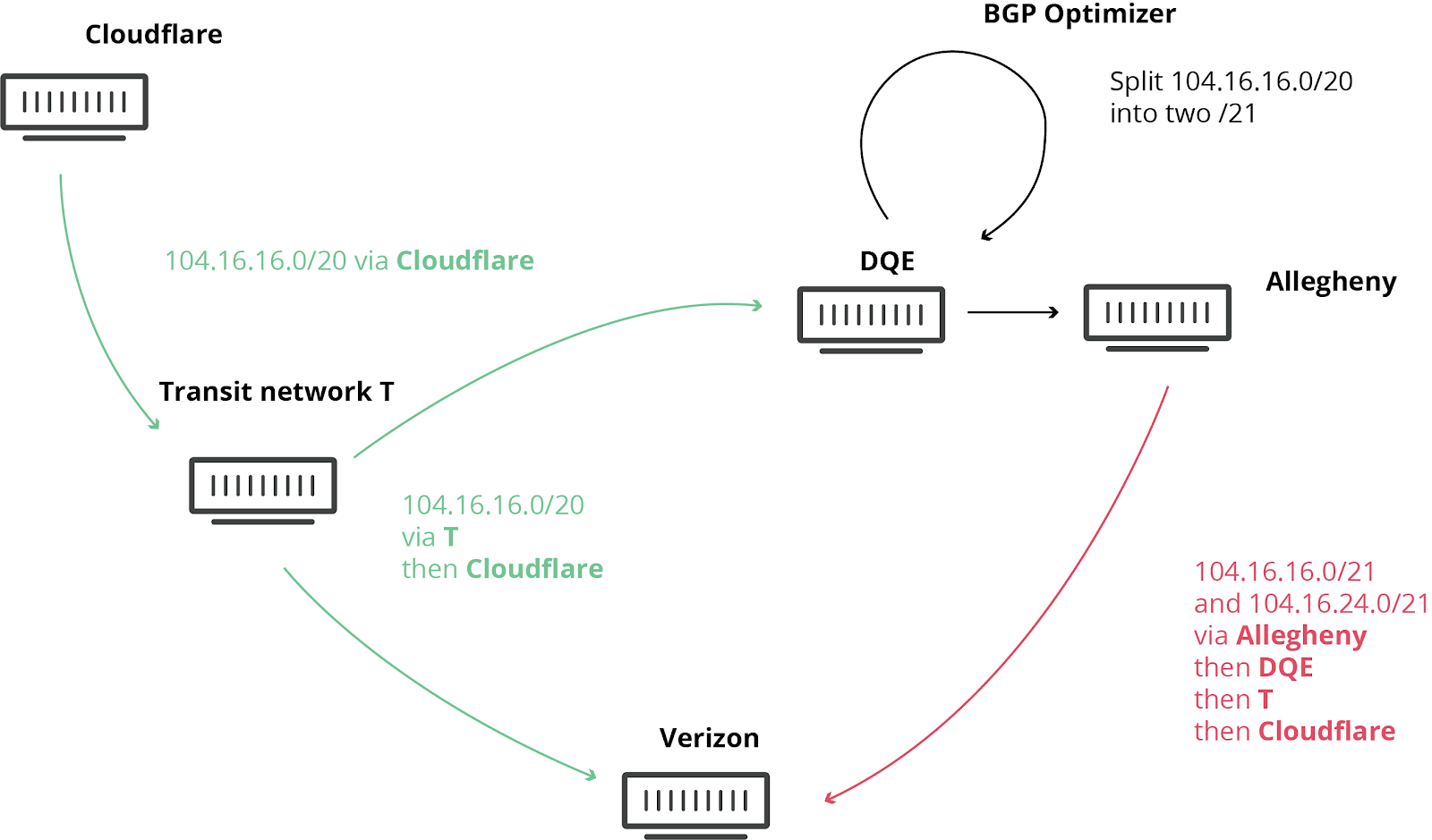Comment Verizon et un optimiseur BGP ont affecté de nombreuses partie d’Internet aujourd’hu
Une fuite massive de routes a eu un impact sur de nombreuses parties d'Internet, y compris sur Cloudflare
Que s'est-il passé ?

Aujourd'hui à 10h30 UTC, Internet a connu une sorte de mini crise cardiaque. Une petite entreprise du nord de la Pennsylvanie est devenue le chemin privilégié de nombreuses routes Internet à cause de Verizon (AS701), un important fournisseur de transit Internet. C’est un peu comme si Waze venait à diriger le trafic d’une autoroute complète vers une petite rue de quartier : de nombreux sites Web sur Cloudflare et beaucoup d’autres fournisseurs étaient indisponibles depuis une grande partie du réseau. Cet incident n'aurait jamais dû arriver, car Verizon n'aurait jamais dû transmettre ces itinéraires au reste d’Internet. Pour en comprendre les raisons, lisez la suite de cet article.
Nous avons déjà écrit un certain nombre d’articles par le passé sur ces événements malheureux qui sont plus fréquents qu’on ne le pense. Cette fois, les effets ont pu être observés dans le monde entier. Aujourd’hui, le problème a été aggravé par l’implication d’un produit « Optimiseur BGP » de Noction. Ce produit dispose d’une fonctionnalité qui permet de diviser les préfixes IP reçus en parties contributives plus petites (appelées « Continue reading
Comment Verizon et un optimiseur BGP ont affecté de nombreuses partie d’Internet aujourd’hu
Une fuite massive de routes a eu un impact sur de nombreuses parties d'Internet, y compris sur Cloudflare
Que s'est-il passé ?

Aujourd'hui à 10h30 UTC, Internet a connu une sorte de mini crise cardiaque. Une petite entreprise du nord de la Pennsylvanie est devenue le chemin privilégié de nombreuses routes Internet à cause de Verizon (AS701), un important fournisseur de transit Internet. C’est un peu comme si Waze venait à diriger le trafic d’une autoroute complète vers une petite rue de quartier : de nombreux sites Web sur Cloudflare et beaucoup d’autres fournisseurs étaient indisponibles depuis une grande partie du réseau. Cet incident n'aurait jamais dû arriver, car Verizon n'aurait jamais dû transmettre ces itinéraires au reste d’Internet. Pour en comprendre les raisons, lisez la suite de cet article.
Nous avons déjà écrit un certain nombre d’articles par le passé sur ces événements malheureux qui sont plus fréquents qu’on ne le pense. Cette fois, les effets ont pu être observés dans le monde entier. Aujourd’hui, le problème a été aggravé par l’implication d’un produit « Optimiseur BGP » de Noction. Ce produit dispose d’une fonctionnalité qui permet de diviser les préfixes IP reçus en parties contributives plus petites (appelées « Continue reading
Tech Bytes: Intent Engineering And Intelligent Networking With Gluware (Sponsored)
Gluware sponsors today's Tech Bytes episode. Greg Ferro and Gluware CEO Jeff Gray discuss network automation, how Gluware's software works, how it lets you solve immediate problems in your current environment while working toward intent, and more.Tech Bytes: Intent Engineering And Intelligent Networking With Gluware (Sponsored)
Gluware sponsors today's Tech Bytes episode. Greg Ferro and Gluware CEO Jeff Gray discuss network automation, how Gluware's software works, how it lets you solve immediate problems in your current environment while working toward intent, and more.
The post Tech Bytes: Intent Engineering And Intelligent Networking With Gluware (Sponsored) appeared first on Packet Pushers.
Today is a bit of a sad day for Network Collective…
It’s with quite a heavy heart that that I’m announcing that Russ White and Eyvonne Sharp are both stepping away from organizational responsibilities at Network Collective. There is no question that this is a significant loss on both accounts. Both Russ and Eyvonne have played irreplaceable roles in building Network Collective into what it is today, and those contributions cannot be understated. I’m grateful for every ounce of effort, wisdom, and perspective that they have invested into the podcast and wish nothing but success to the both of them as they move into new endeavors. Luckily both will still be around in the member’s slack and hopefully on a show or two every once in a while!
What does this mean for Network Collective?
First, Network Collective as you know it isn’t going anywhere. Clearly, I’m going to have to take a step back and evaluate how things proceed from here. We’ve made many plans with the intention of three active contributors and now that’s simply not the case. You might notice some blips in the production schedule and changes to the lineup of podcasts as I get things rearranged and streamlined for a one-person shop.
History of Networking
History Continue reading
Network Break 240: HPE ‘Cloudless’ Trolls Competitors; Riverbed Plugs SD-WAN Hole With Versa
HPE trolls the tech industry with a "cloudless" marketing campaign, Riverbed partners with Versa to bolster its SD-WAN portfolio, a startup dabbles in peer-to-peer networking and cryptocurrency, GE releases an unintentional parody video on the perils of IoT and more tech news on today's Network Break podcast.
The post Network Break 240: HPE ‘Cloudless’ Trolls Competitors; Riverbed Plugs SD-WAN Hole With Versa appeared first on Packet Pushers.
First-hand Feedback: ipSpace.net Network Automation Course
Daniel Teycheney attended the Spring 2019 Building Network Automation Solutions online course and sent me this feedback after completing it (and creating some interesting real-life solutions on the way):
I spent a bit of time the other day reflecting on how much I’ve learn’t from the course in terms of technical skills and the amount I’ve learned has been great. I literally no idea about things like Git, Jinja2, CI testing, reading YAML files and had only briefly seen Ansible before.
I’m not an expert now, but I understand these things and have real practical experience on these subjects which has given me great confidence to push on and keep getting better.
Read more ...The Internet Is Your Oyster: MANRS at International Telecoms Week

What do oysters, clams, and mussels have in common with network operators? Hint: it’s not just that they are both in Atlanta this week, either in exhibits in the Georgia Aquarium or for the 2019 International Telecoms Week.
It’s that both bivalves and network operators play an incredibly important role for their ecosystems: they filter the bad stuff out and leave things a lot cleaner.
As water quality is vital to life in the ocean, the global routing system is vital to the smooth functioning of the Internet. The routing system’s decentralized structure, made up of thousands of independent networks tied together through business decisions and trusted relationships, provides flexibility, scalability, and overall durability.
However, despite its strengths, thousands of routing incidents occur every year. Some of these can be pretty scary, with route hijacks sending government traffic through the networks of foreign adversaries; route leaks slowing parts of the global Internet to a crawl; or hackers using spoofed traffic to take down websites in distributed denial of service (DDoS) attacks.
Network operators can help mitigate these problems by using stronger filtering policies to block spoofed traffic coming from their networks (helping guard against DDoS attacks) and filter route announcements Continue reading
The Week in Internet News: AI and IoT Could Lead to Industry 4.0

The new revolution: Advances in the Internet of Things and Artificial Intelligence are leading to a fourth industrial revolution, Ars Technica suggests. This so-called Industry 4.0 represents “huge changes in much of the technology we deal with in our daily lives. Some of those changes have been for the better, making our interaction with machines and information more natural and more powerful. Others have helped companies tap into consumers’ relationships, behaviors, locations and innermost thoughts in powerful and often disturbing ways.”
Security gaps: But all is not well in IoT land. Legacy problems related to networking technologies are making IoT security “as bad as it gets,” IoT Hub reports. In addition, staff remotely monitoring IoT sensors don’t have the experience to fix problems.
They’re keeping their eyes on you: The Indian government has found a way to track WhatsApp messages without breaking encryption, Business Insider reports. The surveillance technique involves the government asking the Facebook-owned messaging platform to implement an identifier that would allow law enforcement officials to pinpoint who sent the message without reading it.
A new way to pay: In other Facebook-related news, the company is planning to launch a new cryptocurrency called Libra, The Verge Continue reading
Join Cloudflare & Moz at our next meetup, Serverless in Seattle!


Cloudflare is organizing a meetup in Seattle on Tuesday, June 25th and we hope you can join. We’ll be bringing together members of the developers community and Cloudflare users for an evening of discussion about serverless compute and the infinite number of use cases for deploying code at the edge.
To kick things off, our guest speaker Devin Ellis will share how Moz uses Cloudflare Workers to reduce time to first byte 30-70% by caching dynamic content at the edge. Kirk Schwenkler, Solutions Engineering Lead at Cloudflare, will facilitate this discussion and share his perspective on how to grow and secure businesses at scale.
Next up, Developer Advocate Kristian Freeman will take you through a live demo of Workers and highlight new features of the platform. This will be an interactive session where you can try out Workers for free and develop your own applications using our new command-line tool.
Food and drinks will be served til close so grab your laptop and a friend and come on by!
View Event Details & Register Here
Agenda:
Join Cloudflare & Moz at our next meetup, Serverless in Seattle!


Cloudflare is organizing a meetup in Seattle on Tuesday, June 25th and we hope you can join. We’ll be bringing together members of the developers community and Cloudflare users for an evening of discussion about serverless compute and the infinite number of use cases for deploying code at the edge.
To kick things off, our guest speaker Devin Ellis will share how Moz uses Cloudflare Workers to reduce time to first byte 30-70% by caching dynamic content at the edge. Kirk Schwenkler, Solutions Engineering Lead at Cloudflare, will facilitate this discussion and share his perspective on how to grow and secure businesses at scale.
Next up, Developer Advocate Kristian Freeman will take you through a live demo of Workers and highlight new features of the platform. This will be an interactive session where you can try out Workers for free and develop your own applications using our new command-line tool.
Food and drinks will be served til close so grab your laptop and a friend and come on by!
View Event Details & Register Here
Agenda:
Gitlab Gitaly Error
Gitlab gitaly issue causing 404 and 503 errors.Gitlab Gitaly Error
After a power failure of the instance hosting my gitlab server I began getting errors when trying to access existing projects (404) or create new projects (503) from the web interface. I could see the list of projects but if I clicked on the link to any of them I would get a 404 errors. ...Major Updates to Cisco Certifications Part IIII (CCIE)
The CCIE, now 25 years old, has always been the pinnacle of Cisco certifications. There has been a lot of buzz on the importance of certs, and the CCIE, in the “new” era. For that reason, it’s more important than ever that the CCIE gets updated and stays current.
With Cisco’s new announcements, what is changing with the CCIE?
The first thing to mention, for those that already have a CCIE, is that the recert cycle is now being changed to match the other certs such as CCNA and CCNP, so that the recert cycle is 3 years. This means that the suspended status is gone. The cert is now valid for 3 years and there is no suspended status. This means that you need to keep track of your date because there is no “grace period”, after 3 years, if you miss to recert, you’re out! This also means that effective 24 February 2020, if you are still active or suspended, you get an extra year “for free” and you will be a active CCIE to your new expiration date.
Because the recert cycle is now 3 years, you will need to get 120 CE credits instead of 100, Continue reading
Musing: HPE Cloudless Is A Good Marketing Joke

HPE announced a marketing campaign built around the idea of Cloudless. I see this as a superb bit of trolling as the cloudista faithful have been delightfully duped into talking about HPE and highlighting how narrow minded they are. Most of them don’t even realise just how hard they are being rick-rolled here. Its bloody […]
The post Musing: HPE Cloudless Is A Good Marketing Joke appeared first on EtherealMind.
BT Positions Itself as a Neutral SD-WAN Advisor
BT, a United Kingdom-based telecom operator, says almost all of its current and prospective...
SDxCentral Weekly Wrap: VMware Dives Deeper Into Multi-Cloud Security With Secure State
SDxCentral Weekly Wrap for June 21, 2019: VMware is brining together past security acquisitions;...
Latest Kubernetes Security Flaw Linked to Incomplete Patch of Past Flaw
Joel Smith, who works with the Kubernetes Product Security Committee, described the latest bug as...